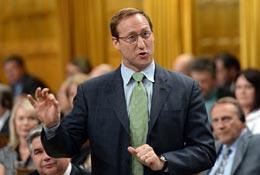Disregard for diversity in selection of judges

Several legal groups are calling on Ottawa for a more accountable process for judicial appointments saying there is an appalling lack of diversity and visible minority judges in Canada.
The Canadian Association of Black Lawyers, the South Asian Bar Association, and the Federation of Asian Canadian Lawyers have joined forces arguing the appointments show a “disregard for diversity” and are calling for change in the selection process.
Last week, the Federation of Asian Canadian Lawyers sent a letter to Justice Minister Peter MacKay asking if the government plans to start collecting information about the makeup of judges.
The letter was sent in response to media reports that found the department of justice doesn’t have any “readily available” information about the diversity of federal judicial appointments from the past 20 years.
It means the government can’t say how many women, visible minorities, French-speakers or aboriginals have been named as federal judges since 1993.
In its letter, the FACL – which represents some 700 members in Ontario, and is affiliated with the National Asian Pacific American Bar Association, which has approximately 40,000 members – asks MacKay three questions:
Does the government keep statistics on the number of judicial applicants who it says do not “self-identify”?
How long will it take the government to gather this information?
Does the government intend to gather and produce this information so that we may better understand where exactly we stand on judicial diversity in Canada?
The letter also says MacKay has twice declined a meeting with the federation’s president to discuss diversity. Another letter shows MacKay also turned down a meeting last summer with the Canadian Association of Black Lawyers, Global news reported.
Lawyer Anna Wong writing in Law Times said a recent round of judicial appointments by Justice Minister Peter MacKay has put the issue of judicial diversity squarely back in the spotlight.
“The latest appointments follow a trend of predominantly white male appointments that reflect neither the diversity of the population served nor that of the legal profession.
Canada has the highest proportion of immigrants among the G8 countries.
Our diverse makeup is hardly evident, however, from the demographics of federal judicial appointees. Between April 2012 and May 2014, only one of 107 new judges appointed by the federal government was from a visible minority group, according to a study by Prof. Rosemary Cairns Way. Gender statistics are similarly dismal.
Women comprise approximately one-third of the bench even as they comprise 51 per cent of the overall population.
“There is much to gain from having a judiciary that reflects society in all its diversity. Diversity on the bench enhances judicial impartiality as well as public confidence in the administration of justice,” said Wong.
“Having a diverse bench, then, enhances impartiality because it means there will be more varied experiences and perspectives from which to draw on in interpreting and applying the law. Women and visible minorities, by virtue of their historical marginality, have a unique frame of reference as outsiders within that renders them suitably positioned to appreciate the assumptions and stereotypes underpinning many legal doctrines and engender previously overlooked interpretations, analyses, and approaches.”
There has been a sustained chorus for better tracking of data and access to the demographic information of applicants for judicial appointments as well as those named to the bench. With transparency comes accountability and an ability to measure progress.
British Columbia releases information on applicants to the provincial court, said Wong.
Under the current federal selection process, eight-member regional judicial advisory committees review written applications. The federal minister of justice nominates three of the eight committee members, something that potentially colours the screening process with a political tint. The committees don’t interview candidates. Instead, they undertake consultations with the legal community and the community at large and designate each applicant as either “recommended” or “unable to recommend.”
The federal minister of justice chooses from among the candidates on the recommended list to put forward to the federal cabinet, which is where political considerations can come into play.









